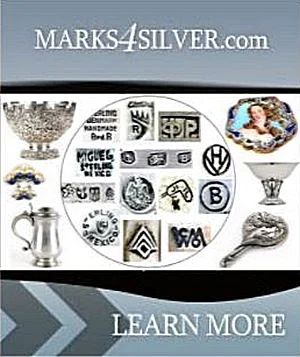Pricing Guides & Dictionary of Makers Marks for Antiques & Collectibles

A few examples of appraisal values for
MOLAS
Search our price guide for your own treasures
-
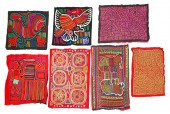 A GROUP OF EIGHT MOLASA group of
A GROUP OF EIGHT MOLASA group of eight molaslargest piece 21 1/2 x 13 1/2 in (54.5 x 34cm)
A GROUP OF EIGHT MOLASA group of
A GROUP OF EIGHT MOLASA group of eight molaslargest piece 21 1/2 x 13 1/2 in (54.5 x 34cm) -
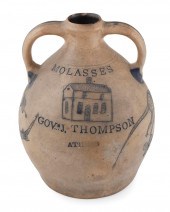 EXTRAORDINARY STONEWARE
EXTRAORDINARY STONEWARE DOUBLE-HANDLED MOLASSES JUG ATHENS, OHIO, 1860S HEIGHT 12.25".EXTRAORDINARY STONEWARE DOUBLE-HANDLED MOLASSES JUG, Athens, Ohio, 1860s, Unique and extensive incised and cobalt blue decoration. Obverse incised "Molasses", "Govr J. Thompson" and "Athens" around a house with a figure in the doorway. Incised below each handle are unique mythical animals, one a half dog-half dragon and the other a half fish-half dragon, both creatures with forked tongues and devil's tails. The half dog-half dragon is pouncing on a blossom and slender leaf, possibly a magnolia. Reverse with an incised leaf, probably an oak leaf. Handles with cobalt blue highlights. Dimensions: Height 12.25". Provenance: The Collection of Bob & Nancy Skinner.Illustrated:The Magazine Antiques, June 1926, cover illustration. Includes a copy of the issue.Notes:Given the menacing nature of the creatures depicted and the lack of a governor named J. Thompson in Ohio history, it is believed this is not a presentation jug but rather a Civil War-era commentary against Confederate Jacob Thompson (1810-1885) of Mississippi. Thompson served in Congress and then as U.S. Secretary of the Interior before resigning at the outbreak of the Civil War to serve as Inspector General of the Confederate States Army and later in the Confederacy's "Secret Service". He was widely denounced in the north as a traitor and conspirator for his involvement, or rumored involvement, in several devious plots, including the assassination of Abraham Lincoln.Thompson's home in Oxford, Mississippi was burned down by Union troops in 1864, which could be the reference for the images seen here, with Thompson the figure in the house, the creatures breathing fire to symbolize the soldiers who set the house ablaze, and the half dog-half dragon trampling a magnolia blossom, an emblem of Mississippi.We can find no official record of Thompson having run for governor, though he may have been a losing candidate during a Civil War-era election. "Gov.r." used here may have been an intentional derogatory slight or was an accidental misuse of the title by the maker.Thompson lived in England and Canada in the years immediately following the Civil War but eventually returned to the United States and settled in Memphis, Tennessee. When he died in 1885, flags in Washington, D.C. were lowered to half-mast in his honor, a recognition that outraged Republicans and Union veterans.
EXTRAORDINARY STONEWARE
EXTRAORDINARY STONEWARE DOUBLE-HANDLED MOLASSES JUG ATHENS, OHIO, 1860S HEIGHT 12.25".EXTRAORDINARY STONEWARE DOUBLE-HANDLED MOLASSES JUG, Athens, Ohio, 1860s, Unique and extensive incised and cobalt blue decoration. Obverse incised "Molasses", "Govr J. Thompson" and "Athens" around a house with a figure in the doorway. Incised below each handle are unique mythical animals, one a half dog-half dragon and the other a half fish-half dragon, both creatures with forked tongues and devil's tails. The half dog-half dragon is pouncing on a blossom and slender leaf, possibly a magnolia. Reverse with an incised leaf, probably an oak leaf. Handles with cobalt blue highlights. Dimensions: Height 12.25". Provenance: The Collection of Bob & Nancy Skinner.Illustrated:The Magazine Antiques, June 1926, cover illustration. Includes a copy of the issue.Notes:Given the menacing nature of the creatures depicted and the lack of a governor named J. Thompson in Ohio history, it is believed this is not a presentation jug but rather a Civil War-era commentary against Confederate Jacob Thompson (1810-1885) of Mississippi. Thompson served in Congress and then as U.S. Secretary of the Interior before resigning at the outbreak of the Civil War to serve as Inspector General of the Confederate States Army and later in the Confederacy's "Secret Service". He was widely denounced in the north as a traitor and conspirator for his involvement, or rumored involvement, in several devious plots, including the assassination of Abraham Lincoln.Thompson's home in Oxford, Mississippi was burned down by Union troops in 1864, which could be the reference for the images seen here, with Thompson the figure in the house, the creatures breathing fire to symbolize the soldiers who set the house ablaze, and the half dog-half dragon trampling a magnolia blossom, an emblem of Mississippi.We can find no official record of Thompson having run for governor, though he may have been a losing candidate during a Civil War-era election. "Gov.r." used here may have been an intentional derogatory slight or was an accidental misuse of the title by the maker.Thompson lived in England and Canada in the years immediately following the Civil War but eventually returned to the United States and settled in Memphis, Tennessee. When he died in 1885, flags in Washington, D.C. were lowered to half-mast in his honor, a recognition that outraged Republicans and Union veterans. -
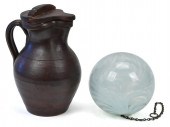 EARLY GLASS WITCHES BALL AND
EARLY GLASS WITCHES BALL AND MOLASSES PITCHER. 19th C. blown glass witches ball with opalescent swirl with chain 6”D, and an earthenware pinched spout molasses pouring pitcher in brown glaze and early wood top, 10”H. Sussman Collection.
EARLY GLASS WITCHES BALL AND
EARLY GLASS WITCHES BALL AND MOLASSES PITCHER. 19th C. blown glass witches ball with opalescent swirl with chain 6”D, and an earthenware pinched spout molasses pouring pitcher in brown glaze and early wood top, 10”H. Sussman Collection. -
 2 ADVERTISING BLACK MEMORABILIA
2 ADVERTISING BLACK MEMORABILIA ALARM CLOCKS.Two Advertising Black Memorabilia Alarm Clocks. 1st: D. B. Scully Syrup Company Molasses, copyright 1938, 5-1/2"h.; 2nd: Fairbanks Gold Dust Washing Powder, copyright 1940, 4-3/4"h. Condition: : Good with losses and wear. Condition: Condition: : Good with losses and wear.
2 ADVERTISING BLACK MEMORABILIA
2 ADVERTISING BLACK MEMORABILIA ALARM CLOCKS.Two Advertising Black Memorabilia Alarm Clocks. 1st: D. B. Scully Syrup Company Molasses, copyright 1938, 5-1/2"h.; 2nd: Fairbanks Gold Dust Washing Powder, copyright 1940, 4-3/4"h. Condition: : Good with losses and wear. Condition: Condition: : Good with losses and wear. -
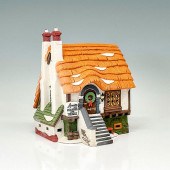 DEPARTMENT 56 FIGURINE, LOMAS
DEPARTMENT 56 FIGURINE, LOMAS LTD. MOLASSESThis figurine depicts a tiny village cottage during the winter holiday season. This item has its original box. Original box's dimensions: 7.5"L x 7.25"W x 9.25"H. Issued: 1993-1996 Dimensions: 5.5"L x 5.75"W x 6.5"H Manufacturer: Department 56 Condition: Age related wear.
DEPARTMENT 56 FIGURINE, LOMAS
DEPARTMENT 56 FIGURINE, LOMAS LTD. MOLASSESThis figurine depicts a tiny village cottage during the winter holiday season. This item has its original box. Original box's dimensions: 7.5"L x 7.25"W x 9.25"H. Issued: 1993-1996 Dimensions: 5.5"L x 5.75"W x 6.5"H Manufacturer: Department 56 Condition: Age related wear. -
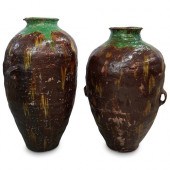 (2 PC) PERUVIAN PALACE SIZED CRETAN
(2 PC) PERUVIAN PALACE SIZED CRETAN OIL JARS(2 Pc) Antique Peruvian palace-sized Cretan oil jars. Originally used for transporting wine, olive oil and molasses these jars feature hand moulded terracotta bodies with a delicately flared upper rim, flanked by three arched handles and finished with a brownish-green drip glaze with hues of mustard yellow. CIRCA: 19th ct ORIGIN: Peru DIMENSIONS: (H: 44" x D: 24") & (H: 47" x D:28") CONDITION: Great condition, slight chips due to age. See lot description for details on item condition. More detailed condition requests can be obtained via email (info@akibaantiques.com) or SMS (305) 333-4134. Any condition statement given, as a courtesy to a client, is only an opinion and should not be treated as a statement of fact. Akiba Antiques shall have no responsibility for any error or omission."
(2 PC) PERUVIAN PALACE SIZED CRETAN
(2 PC) PERUVIAN PALACE SIZED CRETAN OIL JARS(2 Pc) Antique Peruvian palace-sized Cretan oil jars. Originally used for transporting wine, olive oil and molasses these jars feature hand moulded terracotta bodies with a delicately flared upper rim, flanked by three arched handles and finished with a brownish-green drip glaze with hues of mustard yellow. CIRCA: 19th ct ORIGIN: Peru DIMENSIONS: (H: 44" x D: 24") & (H: 47" x D:28") CONDITION: Great condition, slight chips due to age. See lot description for details on item condition. More detailed condition requests can be obtained via email (info@akibaantiques.com) or SMS (305) 333-4134. Any condition statement given, as a courtesy to a client, is only an opinion and should not be treated as a statement of fact. Akiba Antiques shall have no responsibility for any error or omission." -
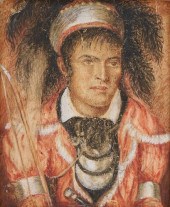 1830 TENNESSEE PORTRAIT MINIATURE
1830 TENNESSEE PORTRAIT MINIATURE OF KINHECHE, CHICKASA...Caroline Dudley (Tennessee, 1802-1832) important watercolor miniature portrait painting, depicting Chickasaw Native American dignitary Kinheche in bright garb and headdress holding a bow and arrow. Inscription identifying subject as "Kinhichi", en verso or interior paper liner, and as "Kinhishee" on the exterior of the back of the frame. Housed in a wooden frame with gilt metal sight edge and oak leaf hanger. Sight: 2 3/4" H x 2 1/4" W. Framed: 6" H x 5" W. Circa 1830. Note: this portrait was painted in Franklin, Tennessee in August of 1830 during the landmark treaty summit between President Andrew Jackson and the Chickasaw Nation, conducted at the city's Masonic Hall. Caroline Dudley was the daughter of a prominent Middle Tennessee settler and leader, Guilford Dudley; both were among the spectators invited to witness the treaty event. According to family history, Miss Dudley was so impressed by the appearance of Kinheche or Kin-hee-shee (who according to some accounts may have been a son of the chief), that she was inspired to paint his likeness. Miss Dudley may have been a teacher of art or other similar subjects at the Young Ladies Boarding School run by her mother, Anna Bland Eaton Dudley on the West Harpeth River in Williamson County from 1809-1840 or at Mrs. Long's School on West Main Street in Franklin, which was run by her sister, Judith from 1826-1828 and 1834-37. After Caroline Dudley's death just two years later at the age of 30, the painting was inherited by her sister Frances and descended in the family to its last private owner, Mary Bright Wilson of Lincoln County, Tennessee. Historical background: "After his Indian Removal Act was passed in May of 1830, President Andrew Jackson invited the Chickasaw Nation to a treaty council to be held the following August in Franklin, Tennessee. During their stay, the Chickasaw delegation met Jackson in the Franklin Masonic Hall, a National Historic Landmark which still stands at 115 2nd Ave South in Franklin. This would be the first treaty negotiation under the Removal Act and a successful outcome was important to the President, who was a charismatic and influential figure among the Chickasaw. Some of the older minkos (chiefs or headmen) had served under Jackson's command at the Battle of New Orleans and the Creek War, during the War of 1812. They called him "Sharpe Knife". Jackson appointed John Coffee and John Eaton as treaty commissioners. Coffee was a long time friend who had also served with Jackson in 1812. Eaton, Jackson's Secretary of War, lived in Franklin. The Chickasaw delegation was led by Levi Colbert - Itawambe Miko (Bench Chief), and included George Colbert, James Colbert, John McLish, Captain William McGilvery, Captain James Brown, Isaac Alberson, Topulka, Ishtayatubbe, Ahtokowa, Hushtatabe, Innewakche, Oaklanayaubbe, Ohekaubbe, Immolasubbe, Immohoaltatubbe, Ishtekieyokatubbe, Ishtehiacha, Inhiyouchetubbe, and Kinheche..." President Jackson met and welcomed the Chickasaw delegation when they arrived in Franklin on August 20, 1830. During the next several days, support for Chickasaw education, Removal expenses, and other related details were worked out. On August 31 the treaty was signed. The Chickasaw agreed to exchange their remaining land in Mississippi and Alabama for land "West of the territory of Arkansaw", with a stipulation that they could examine the land beforehand. If they didn't find suitable land, the treaty would be null and void. A supplemental treaty concerning other details was signed the next day, September 1, and "thereupon, the council broke up." The Chickasaws sent several delegations west of the Mississippi to look for land over the next two years, but nothing suitable was found. In the meantime, the signing of the 1830 Franklin treaty caused a land rush of white squatters anxious to stake their claims before the Chickasaws had even left. By 1832 the Chickasaw Nation was being overrun, even though the Franklin treaty was supposed to prohibit such intrusions. Article 3 extended the protection of the United States to the Chickasaws, but the federal government did nothing to stop the invading squatters - apparently Jackson had let his blade grow dull, at least when it came to protecting Chickasaw land. Since the Chickasaws found no suitable land in the west, the Franklin treaty was considered null and void and was never ratified by Congress. In October, 1832, President Jackson sent John Coffee to the Chickasaw Nation to negotiate a new treaty. Coffee met 65 Chickasaw leaders at the Chickasaw council house on Pontotoc Creek, near present day Tupelo, Mississippi. On October 20, the Chickasaw leaders signed the Treaty of Pontotoc Creek with the United States, agreeing to sell their remaining homeland in Mississippi and Alabama. The Chickasaws became dissatisfied with the Treaty of Pontotoc Creek, believing John Coffee had misrepresented the terms during the negotiations. In 1834 they sent a delegation to Washington, D.C., to amend the treaty. Levi Colbert, then 75 years old, began the journey but became ill and died. Before his death he dictated instructions for the delegation, which included his brother George, who had also been present at the Franklin treaty council. George Colbert and the rest of the delegation then traveled on to Washington and negotiated the desired amendments. In 1837, under the provisions of the Treaty of Doaksville, a treaty between the Chickasaw and Choctaw Nations, the Chickasaw bought a section of Choctaw land in Indian Territory. The people whose allegiance and friendship arguably prevented the destruction of fledgling Nashville and the other Cumberland settlements, and helped shape the map of the southeast to the benefit of the United States, finally left the soil of their birth and removed to the west." Source: The Native American History Association (http://www.nativehistoryassociation.org/franklin_treaty.php) Property of the Lincoln County Museum, Fayetteville, TN; Bequest of Mary Bright Wilson (1909-2004), formerly of Fayetteville, and descended in her family. Condition: 1" separation to upper right edge (near corner), otherwise overall good condition. Frame is old, but may or may not be original.
1830 TENNESSEE PORTRAIT MINIATURE
1830 TENNESSEE PORTRAIT MINIATURE OF KINHECHE, CHICKASA...Caroline Dudley (Tennessee, 1802-1832) important watercolor miniature portrait painting, depicting Chickasaw Native American dignitary Kinheche in bright garb and headdress holding a bow and arrow. Inscription identifying subject as "Kinhichi", en verso or interior paper liner, and as "Kinhishee" on the exterior of the back of the frame. Housed in a wooden frame with gilt metal sight edge and oak leaf hanger. Sight: 2 3/4" H x 2 1/4" W. Framed: 6" H x 5" W. Circa 1830. Note: this portrait was painted in Franklin, Tennessee in August of 1830 during the landmark treaty summit between President Andrew Jackson and the Chickasaw Nation, conducted at the city's Masonic Hall. Caroline Dudley was the daughter of a prominent Middle Tennessee settler and leader, Guilford Dudley; both were among the spectators invited to witness the treaty event. According to family history, Miss Dudley was so impressed by the appearance of Kinheche or Kin-hee-shee (who according to some accounts may have been a son of the chief), that she was inspired to paint his likeness. Miss Dudley may have been a teacher of art or other similar subjects at the Young Ladies Boarding School run by her mother, Anna Bland Eaton Dudley on the West Harpeth River in Williamson County from 1809-1840 or at Mrs. Long's School on West Main Street in Franklin, which was run by her sister, Judith from 1826-1828 and 1834-37. After Caroline Dudley's death just two years later at the age of 30, the painting was inherited by her sister Frances and descended in the family to its last private owner, Mary Bright Wilson of Lincoln County, Tennessee. Historical background: "After his Indian Removal Act was passed in May of 1830, President Andrew Jackson invited the Chickasaw Nation to a treaty council to be held the following August in Franklin, Tennessee. During their stay, the Chickasaw delegation met Jackson in the Franklin Masonic Hall, a National Historic Landmark which still stands at 115 2nd Ave South in Franklin. This would be the first treaty negotiation under the Removal Act and a successful outcome was important to the President, who was a charismatic and influential figure among the Chickasaw. Some of the older minkos (chiefs or headmen) had served under Jackson's command at the Battle of New Orleans and the Creek War, during the War of 1812. They called him "Sharpe Knife". Jackson appointed John Coffee and John Eaton as treaty commissioners. Coffee was a long time friend who had also served with Jackson in 1812. Eaton, Jackson's Secretary of War, lived in Franklin. The Chickasaw delegation was led by Levi Colbert - Itawambe Miko (Bench Chief), and included George Colbert, James Colbert, John McLish, Captain William McGilvery, Captain James Brown, Isaac Alberson, Topulka, Ishtayatubbe, Ahtokowa, Hushtatabe, Innewakche, Oaklanayaubbe, Ohekaubbe, Immolasubbe, Immohoaltatubbe, Ishtekieyokatubbe, Ishtehiacha, Inhiyouchetubbe, and Kinheche..." President Jackson met and welcomed the Chickasaw delegation when they arrived in Franklin on August 20, 1830. During the next several days, support for Chickasaw education, Removal expenses, and other related details were worked out. On August 31 the treaty was signed. The Chickasaw agreed to exchange their remaining land in Mississippi and Alabama for land "West of the territory of Arkansaw", with a stipulation that they could examine the land beforehand. If they didn't find suitable land, the treaty would be null and void. A supplemental treaty concerning other details was signed the next day, September 1, and "thereupon, the council broke up." The Chickasaws sent several delegations west of the Mississippi to look for land over the next two years, but nothing suitable was found. In the meantime, the signing of the 1830 Franklin treaty caused a land rush of white squatters anxious to stake their claims before the Chickasaws had even left. By 1832 the Chickasaw Nation was being overrun, even though the Franklin treaty was supposed to prohibit such intrusions. Article 3 extended the protection of the United States to the Chickasaws, but the federal government did nothing to stop the invading squatters - apparently Jackson had let his blade grow dull, at least when it came to protecting Chickasaw land. Since the Chickasaws found no suitable land in the west, the Franklin treaty was considered null and void and was never ratified by Congress. In October, 1832, President Jackson sent John Coffee to the Chickasaw Nation to negotiate a new treaty. Coffee met 65 Chickasaw leaders at the Chickasaw council house on Pontotoc Creek, near present day Tupelo, Mississippi. On October 20, the Chickasaw leaders signed the Treaty of Pontotoc Creek with the United States, agreeing to sell their remaining homeland in Mississippi and Alabama. The Chickasaws became dissatisfied with the Treaty of Pontotoc Creek, believing John Coffee had misrepresented the terms during the negotiations. In 1834 they sent a delegation to Washington, D.C., to amend the treaty. Levi Colbert, then 75 years old, began the journey but became ill and died. Before his death he dictated instructions for the delegation, which included his brother George, who had also been present at the Franklin treaty council. George Colbert and the rest of the delegation then traveled on to Washington and negotiated the desired amendments. In 1837, under the provisions of the Treaty of Doaksville, a treaty between the Chickasaw and Choctaw Nations, the Chickasaw bought a section of Choctaw land in Indian Territory. The people whose allegiance and friendship arguably prevented the destruction of fledgling Nashville and the other Cumberland settlements, and helped shape the map of the southeast to the benefit of the United States, finally left the soil of their birth and removed to the west." Source: The Native American History Association (http://www.nativehistoryassociation.org/franklin_treaty.php) Property of the Lincoln County Museum, Fayetteville, TN; Bequest of Mary Bright Wilson (1909-2004), formerly of Fayetteville, and descended in her family. Condition: 1" separation to upper right edge (near corner), otherwise overall good condition. Frame is old, but may or may not be original. -
 TWO FRAMED PANAMANIAN MOLASTwo
TWO FRAMED PANAMANIAN MOLASTwo framed Panamanian molas. Not examined out of frames. Smaller with bloom on glass. Largest sight size: 10" high, 15 1/4" wide. Smallest: 6 1/4" high, 7 5/8" wide. Largest frame size: 16 1/4" high, 21" wide. Smallest: 12 1/4" high, 13 1/4" wide. Condition: Any condition information included in our lot descriptions is not the equivalent of a written condition statement, and the absence of condition information does not imply that the lot is free of defects. Our auction lot descriptions reflect our effort to provide accurate, objective and fair information on all lots for sale, and we encourage bidders to request written condition statements and large file images on any lots of interest by emailing condition@woodburyauction.com. We also strongly advise that you or someone on your behalf inspect the lot personally before bidding. All lots are sold "as is" and "where is" and neither we nor any consignor makes any warranties or representation of any kind or nature with respect to the property. There are no returns and no refunds based on condition.
TWO FRAMED PANAMANIAN MOLASTwo
TWO FRAMED PANAMANIAN MOLASTwo framed Panamanian molas. Not examined out of frames. Smaller with bloom on glass. Largest sight size: 10" high, 15 1/4" wide. Smallest: 6 1/4" high, 7 5/8" wide. Largest frame size: 16 1/4" high, 21" wide. Smallest: 12 1/4" high, 13 1/4" wide. Condition: Any condition information included in our lot descriptions is not the equivalent of a written condition statement, and the absence of condition information does not imply that the lot is free of defects. Our auction lot descriptions reflect our effort to provide accurate, objective and fair information on all lots for sale, and we encourage bidders to request written condition statements and large file images on any lots of interest by emailing condition@woodburyauction.com. We also strongly advise that you or someone on your behalf inspect the lot personally before bidding. All lots are sold "as is" and "where is" and neither we nor any consignor makes any warranties or representation of any kind or nature with respect to the property. There are no returns and no refunds based on condition. -
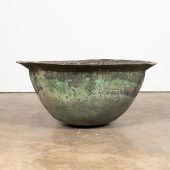 LARGE JAMAICAN COPPER SUGAR OR
LARGE JAMAICAN COPPER SUGAR OR MOLASSES KETTLE Jamaican, 19th century. Large copper sugar or molasses kettle, having a flared rim. Unmarked. Provenance: The Private Collection of Mr. Noel F. Parris, Fayetteville, Georgia.
LARGE JAMAICAN COPPER SUGAR OR
LARGE JAMAICAN COPPER SUGAR OR MOLASSES KETTLE Jamaican, 19th century. Large copper sugar or molasses kettle, having a flared rim. Unmarked. Provenance: The Private Collection of Mr. Noel F. Parris, Fayetteville, Georgia. -
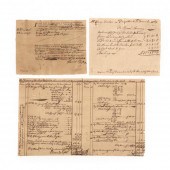 THREE MARITIME DOCUMENTS ASSOCIATED
THREE MARITIME DOCUMENTS ASSOCIATED WITH COLONIAL NORTH CAROLINA To include: partially printed Document Signed "Samuel Clark," New Providence (Bahamas), November 18, 1762, 8vo, being a bill of lading for molasses and sugar bound for New Bern, North Carolina aboard the Sea Horse, the verso with a Autograph Note Signed "Isaac Van Dam," November 25, 1762, to agents in North Carolina (browning with tape residue on the back, else very good condition); Manuscript Document, "Parspotanck" (Pasquotank River, NC), December 21, 1767, 8vo, listing fees due Isaac Amory from Mrs. Mary Fowlarr and son for passage from London to North Carolina (light browning, some tape residue; very good condition); Autograph Document Signed "Peter Smith," Pasquotank River, North Carolina, July 1, 1772, one page, oblong 4to, being an account of goods sold by Peter Smith in North Carolina for the owners of the Sloop Dolphin. Buyers named include William Littlejohn, William Scarborough, John Crawford, and William Taylor. (even browning; chip along bottom edge, tape residue in corners).
THREE MARITIME DOCUMENTS ASSOCIATED
THREE MARITIME DOCUMENTS ASSOCIATED WITH COLONIAL NORTH CAROLINA To include: partially printed Document Signed "Samuel Clark," New Providence (Bahamas), November 18, 1762, 8vo, being a bill of lading for molasses and sugar bound for New Bern, North Carolina aboard the Sea Horse, the verso with a Autograph Note Signed "Isaac Van Dam," November 25, 1762, to agents in North Carolina (browning with tape residue on the back, else very good condition); Manuscript Document, "Parspotanck" (Pasquotank River, NC), December 21, 1767, 8vo, listing fees due Isaac Amory from Mrs. Mary Fowlarr and son for passage from London to North Carolina (light browning, some tape residue; very good condition); Autograph Document Signed "Peter Smith," Pasquotank River, North Carolina, July 1, 1772, one page, oblong 4to, being an account of goods sold by Peter Smith in North Carolina for the owners of the Sloop Dolphin. Buyers named include William Littlejohn, William Scarborough, John Crawford, and William Taylor. (even browning; chip along bottom edge, tape residue in corners). -
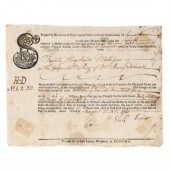 IMPORTANT COLONIAL RHODE ISLAND
IMPORTANT COLONIAL RHODE ISLAND BILL OF LADING WITH NAUTICAL ENGRAVING Being a partially printed Document Signed "Eben'r Taylor" (Ebenezer Taylor), Newport, Rhode Island, October 2, 1750, one page, small 8vo, the first letter of the printed text is an elaborate engraved initial incorporating a galleon under full sail, this introduction followed by manuscript lines recording "Twenty Hogsheads of Molasses" belonging to Samuel Vernon of Newport being shipped to Henry Darrall of Boston on board the sloop Success.
IMPORTANT COLONIAL RHODE ISLAND
IMPORTANT COLONIAL RHODE ISLAND BILL OF LADING WITH NAUTICAL ENGRAVING Being a partially printed Document Signed "Eben'r Taylor" (Ebenezer Taylor), Newport, Rhode Island, October 2, 1750, one page, small 8vo, the first letter of the printed text is an elaborate engraved initial incorporating a galleon under full sail, this introduction followed by manuscript lines recording "Twenty Hogsheads of Molasses" belonging to Samuel Vernon of Newport being shipped to Henry Darrall of Boston on board the sloop Success. -
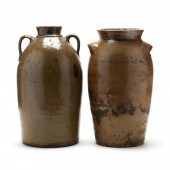 TWO NORTH CAROLINA POTTERY
TWO NORTH CAROLINA POTTERY VESSELS Late 19th century, salt glazed stoneware, three gallon size, the first is a molasses jar with a high collar, double incised lines at the attachment of the small arched handles (17 3/4 in.) (allover blisters or craters, some popped; slight handle roughness; small rim flake) not signed; the second is a storage jar stamped "J.H. SPENCER" (Randolph County) with coggle wheel 3 (17 1/4 in.) (rim chips; both handles repaired; extensive glaze erosion).
TWO NORTH CAROLINA POTTERY
TWO NORTH CAROLINA POTTERY VESSELS Late 19th century, salt glazed stoneware, three gallon size, the first is a molasses jar with a high collar, double incised lines at the attachment of the small arched handles (17 3/4 in.) (allover blisters or craters, some popped; slight handle roughness; small rim flake) not signed; the second is a storage jar stamped "J.H. SPENCER" (Randolph County) with coggle wheel 3 (17 1/4 in.) (rim chips; both handles repaired; extensive glaze erosion). -
 TWO MEXICAN EMBROIDERED MOLAS AND
TWO MEXICAN EMBROIDERED MOLAS AND EGYPTIAN PIECED COTTON PICTURE OF BULLTwo Mexican Embroidered Molas and Egyptian Pieced Cotton Picture of Bull
TWO MEXICAN EMBROIDERED MOLAS AND
TWO MEXICAN EMBROIDERED MOLAS AND EGYPTIAN PIECED COTTON PICTURE OF BULLTwo Mexican Embroidered Molas and Egyptian Pieced Cotton Picture of Bull -
 FOUR ACCOUNTING BOOKS, ONE HALL
FOUR ACCOUNTING BOOKS, ONE HALL GREEN & LOCKE (GENERAL STORE), OCTOBER 12, 1818-OCTOBER 23, 1819, LOTS OF "CALICO" COTTON, ETC; AND...Four accounting books, one Hall Green & Locke (general store), October 12, 1818-October 23, 1819, lots of "Calico" cotton, etc; and one from another general store dated June 26, 1820-April 7, 1821, selling "Calico" cotton, gloves, molasses, no location viewed; along with two blank account books; wear on all consistent with age and significant daily use, including scattered tattered pages, wear to edges and corners, etc.
FOUR ACCOUNTING BOOKS, ONE HALL
FOUR ACCOUNTING BOOKS, ONE HALL GREEN & LOCKE (GENERAL STORE), OCTOBER 12, 1818-OCTOBER 23, 1819, LOTS OF "CALICO" COTTON, ETC; AND...Four accounting books, one Hall Green & Locke (general store), October 12, 1818-October 23, 1819, lots of "Calico" cotton, etc; and one from another general store dated June 26, 1820-April 7, 1821, selling "Calico" cotton, gloves, molasses, no location viewed; along with two blank account books; wear on all consistent with age and significant daily use, including scattered tattered pages, wear to edges and corners, etc. -
 BLACK AMERICANA: FIVE TIN
BLACK AMERICANA: FIVE TIN CONTAINERS WITH AFRICAN AMERICAN PAPER LABEL ADVERTISING, C. 1925 - 30'S, INCLUDING: STORE TIN FOR ZANZIBA...BLACK AMERICANA: Five tin containers with African American paper label advertising, c. 1925 - 30''s, including: store tin for Zanzibar-Brand Seasoning depicting semi-nude African women, c. 1924, applied label, some discoloration and missing pieces of labels, tin has dents and scuffing, 11" h. x 8 1/4" w. x 8 1/4" d.; and four smaller tin containers, c. 1930''s: "Uncle Remus Syrup", 4 1/8" diameter x 4 1/2", minor pieces missing from label; "Topsy Molasses", pieces missing from label, discoloration, 3 1/2" diameter x 5"; "Aunt Dinah Molasses", some discoloration in label, holes punched in lid, 4" diameter x 4 1/2"; "Scully''s Mary Anne Molasses", discoloration in label, 4" h., all pieces with wear consistent with age and use including toning, minor damages and loss.
BLACK AMERICANA: FIVE TIN
BLACK AMERICANA: FIVE TIN CONTAINERS WITH AFRICAN AMERICAN PAPER LABEL ADVERTISING, C. 1925 - 30'S, INCLUDING: STORE TIN FOR ZANZIBA...BLACK AMERICANA: Five tin containers with African American paper label advertising, c. 1925 - 30''s, including: store tin for Zanzibar-Brand Seasoning depicting semi-nude African women, c. 1924, applied label, some discoloration and missing pieces of labels, tin has dents and scuffing, 11" h. x 8 1/4" w. x 8 1/4" d.; and four smaller tin containers, c. 1930''s: "Uncle Remus Syrup", 4 1/8" diameter x 4 1/2", minor pieces missing from label; "Topsy Molasses", pieces missing from label, discoloration, 3 1/2" diameter x 5"; "Aunt Dinah Molasses", some discoloration in label, holes punched in lid, 4" diameter x 4 1/2"; "Scully''s Mary Anne Molasses", discoloration in label, 4" h., all pieces with wear consistent with age and use including toning, minor damages and loss. -
 GROUP OF FIVE SOUTH AMERICAN
GROUP OF FIVE SOUTH AMERICAN CLOTH MOLAS, FRAMEDGroup of Five South American Cloth Molas, Framed,
GROUP OF FIVE SOUTH AMERICAN
GROUP OF FIVE SOUTH AMERICAN CLOTH MOLAS, FRAMEDGroup of Five South American Cloth Molas, Framed, -
 2pc Framed Kuna Indian Molas.
2pc Framed Kuna Indian Molas. Hand Stitched Colorful Appliqued Fabrics. Figural images of Bird and animals. Framed. Dimensions: H: 14.5 inches: W: 18 inches: Frame Height: 23.5 inches: Frame Width: 27 inches --- Condition: Light wear.
2pc Framed Kuna Indian Molas.
2pc Framed Kuna Indian Molas. Hand Stitched Colorful Appliqued Fabrics. Figural images of Bird and animals. Framed. Dimensions: H: 14.5 inches: W: 18 inches: Frame Height: 23.5 inches: Frame Width: 27 inches --- Condition: Light wear. -
 2pc Framed Kuna Indian Molas.
2pc Framed Kuna Indian Molas. Hand Stitched Colorful Appliqued Fabrics. Smaller with figural images of birds and Flora. Larger has human figures and anchors. Framed. Dimensions: H: 14.5 inches: W: 38.5 inches --- Condition: Light wear.
2pc Framed Kuna Indian Molas.
2pc Framed Kuna Indian Molas. Hand Stitched Colorful Appliqued Fabrics. Smaller with figural images of birds and Flora. Larger has human figures and anchors. Framed. Dimensions: H: 14.5 inches: W: 38.5 inches --- Condition: Light wear. -
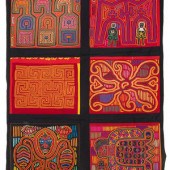 A Collection of Panamanian Molas
A Collection of Panamanian Molas Panels 20th Century comprising of 26 individual panels, one group of 6 stitched panels and one group of 9 stitched panels. Largest stitched panel 49 x 60 inches.
A Collection of Panamanian Molas
A Collection of Panamanian Molas Panels 20th Century comprising of 26 individual panels, one group of 6 stitched panels and one group of 9 stitched panels. Largest stitched panel 49 x 60 inches. -
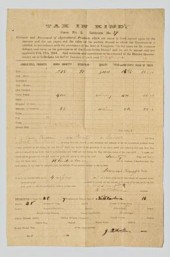 Confederate plantation archive of
Confederate plantation archive of Jeremiah Henry, Anson County, North Carolina: three partially printed "Tax in Kind" forms, 1864-65, listing amounts of bacon, corn, fodder, molasses, etc., tithed to the Confederate government; five pieces North Carolina currency, one Monroe, North Carolina, 1863, receivable for taxes "For Relief of Soldiers' Families"; 1863 affidavit for cotton yarn, sworn "for family use and not for sale, exchange or barter"; 1865 "C.S. Government" printed receipt for hire of wagon and team; 1866 receipt for "four coffins for Negroes who died on the plantation"; 1857 receipt for hire of "Negro girl named "Martha", 3-1/2 x 1 in. signature portion removed ; six cotton sale bills, 1850-1869; 1-3/4 x 2-7/8 in. to 18 x 12 in., (18 pieces). Separations, small losses, folds, stains, toning. The Estate of the Late Henry Gregory, Charlotte, North Carolina
Confederate plantation archive of
Confederate plantation archive of Jeremiah Henry, Anson County, North Carolina: three partially printed "Tax in Kind" forms, 1864-65, listing amounts of bacon, corn, fodder, molasses, etc., tithed to the Confederate government; five pieces North Carolina currency, one Monroe, North Carolina, 1863, receivable for taxes "For Relief of Soldiers' Families"; 1863 affidavit for cotton yarn, sworn "for family use and not for sale, exchange or barter"; 1865 "C.S. Government" printed receipt for hire of wagon and team; 1866 receipt for "four coffins for Negroes who died on the plantation"; 1857 receipt for hire of "Negro girl named "Martha", 3-1/2 x 1 in. signature portion removed ; six cotton sale bills, 1850-1869; 1-3/4 x 2-7/8 in. to 18 x 12 in., (18 pieces). Separations, small losses, folds, stains, toning. The Estate of the Late Henry Gregory, Charlotte, North Carolina -
 TWO JUGS. American 2nd
TWO JUGS. American 2nd half-19th century yellow clay. Both have Albany slip and applied handles. Molasses jug with impressed label ''Farmington Elmira NY'' and incised ''Gerity Bros.'' 8''h. and a miniature jug incised ''Little Brown Jug''. Repaired flake. 3''h.
TWO JUGS. American 2nd
TWO JUGS. American 2nd half-19th century yellow clay. Both have Albany slip and applied handles. Molasses jug with impressed label ''Farmington Elmira NY'' and incised ''Gerity Bros.'' 8''h. and a miniature jug incised ''Little Brown Jug''. Repaired flake. 3''h. -
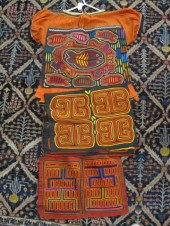 Lot of Panama Molas textiles
Lot of Panama Molas textiles includes blouseand unframed examples
Lot of Panama Molas textiles
Lot of Panama Molas textiles includes blouseand unframed examples -
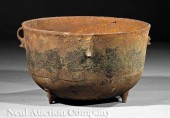 An Antique American Cast Iron
An Antique American Cast Iron Molasses Kettle Louisiana flared form with four handles dished bottom on tapering feet height 14 in. width 23 3/4 in. depth 23 3/4 in.
An Antique American Cast Iron
An Antique American Cast Iron Molasses Kettle Louisiana flared form with four handles dished bottom on tapering feet height 14 in. width 23 3/4 in. depth 23 3/4 in. -
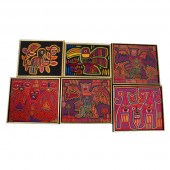 Panamanian Molas Panama 20th
Panamanian Molas Panama 20th century. A group of ten Panamanian molas seven framed and unglazed three unframed; ht. 15.75 wd. 14 in. Condition: Some fading some stains.
Panamanian Molas Panama 20th
Panamanian Molas Panama 20th century. A group of ten Panamanian molas seven framed and unglazed three unframed; ht. 15.75 wd. 14 in. Condition: Some fading some stains. -
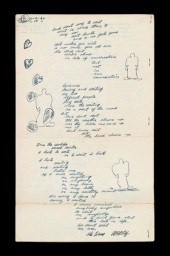 Lot. Autograph Material.
Lot. Autograph Material. Guthrie, Woody. Archive of Autograph Letters Signed, Autograph Manuscript & Typescript Short Stories, Signed Ephemera & other related material: Autograph Letters Signed, all to Charlotte Straus of Philadelphia, all but the last from U.S. military bases on which Guthrie was serving as a private: Scott Field, Ill., Oct. 29, 1945. 4to, 5 pp.; Scott Field, Ill., Nov 3, 1945. 4to, 8 pp.; Las Vegas, Dec. 5, 1945. 4to, 5 pp.; Las Vegas, Dec. 8, 1945. 4to, 4 pp.; Las Vegas, Dec. 8, 1945. 4to, 4 pp.; Las Vegas, Dec. 8, 1945. 4to, 10 pp.; Las Vegas, Dec. 10, 1945. 4to, 4 pp.; Las Vegas, Dec. 18, 1945. 4to, 18 pp. - bottom 1/2 of the last leaf of this letter is clipped away, removing its text & presumably Guthrie's signature; Las Vegas, Dec. 21, [19]45, 4to, 4 pp.; Brooklyn, Jan. 2, 1946, 4to, 1 p.; [Stroud]sburg, Pa., Oct. 8, 1946, folio, 8 pp. Autograph Manuscript Short Story Signed. "I Spin, You Spin." 4to, 6 pp., in ink, signed, "Woody Guthrie / Sept. 15, 1946, Delaware Water Gap." Some dampstaining - no text obscured. * Another copy of the preceding, 4to, 6 pp., in pencil, signed, "Woody Guthrie, Sept. 15, 1946." Typescript Short Story. "Study Butte." 4to, 27 pp. With autograph signed inscription [to Charlotte Straus] on gutter margin of p. 1, signed , "Woody, 10-3-1917." 1 vol. Guthrie, Woody. American Folksong - cover title. N.p., n.d. 4to, orig. flexible bds. Inscribed & signed to Charlotte Straus in ink. Pencil & watercolor letters on front & back endpapers, dated, "May 28, 1947," variously signed as "Woody" & "W.G." Record Album. "Documentary #1 Struggle." Three 78 records in orig. sleeve, featuring "Buffalo Skinners" & 4 more songs by Woody Guthrie (album includes 1 song by Sonny Terry). Inscribed to Charlotte [Straus] & signed by "Woody, Marjorie & Cathy" [Guthrie] on part sleeve of "Buffalo Skinners" record, Woody has added, apparently refering to the song, "This is me struggling." Disc Company of America. "Songs To Grow On, Nursery Days." New York, n.d. Printed sheet folded in 8 12mo pp. With songs by Woody Guthrie written for his children & Disc Company adverts. for other of their Children's records. On title, "Our latest album / Woody Guthrie," in Guthrie's hand. Charlotte Straus of Philadelphia wrote to Woody Guthrie in 1945 after reading his book Bound for Glory. Guthrie responded to her letter on Oct. 29, 1945, while in service as a private in the American armed forces. His letter warmly acknowledged Charlotte's apparently rich & sympathetic response to his work. A warm & intimate correspondence, recorded on Guthrie's side by the letters above, developed between Oct. 29, 1945 & Oct. 8, 1946. Guthrie's reverie-filled letters offer Straus intimate reflections, "I want to tell you that 90% of your whole letter set up some pretty sad aches and pains in me" (Nov. 3, 1945) & whimsy, "Here's eight pages of molasses to go all over your pancakes" (Dec. 8, 1945), reflections on their relationship & his response to the desert surrounding his Las Vegas service base, "The desert is so lonesome that she blows a cold air across her bosom. You have a way of making me want to [?] down and buy more smokes and to set here in the window and look down across the barracks and write what crosses my mind" (Dec. 10, 1945); "You made me recall my trips all back through myself" (Dec. 21, 1945); "I had some writing on my mind, writing that the health book speaks about caused by fights in your head you must get out caused by some general visions whirling there of dreams you see and know and ones you doubt" (Dec. 8, 1945). Guthrie also discusses his work, praises Charlotte's passion for & knowledge of folk music, describes his domestic life including his wife Marjorie's attitude & background, "her mother Eliza Greenblatt, is one of the finest of the Yiddish... poetesses of the beauty for beauty's sake generation (Dec. 18, 1945). The letter of Dec. 8, 1945 includes eight pages of Guthrie song lyrics, beginning, "Take this and climb a hill somewhere away / From your factory and from / your night and from your day / and lay your head down on your chosen spot / and say yourself what these words fail to say." The letter of Oct. 8, 1946 from Stroudsburg, Pa. closes with three pages of song lyrics & drawings of figures & hearts on its last page. Altogether a privileged and detailed entry into Woody Guthrie's intertwined personal & professional lives. ,000-12,000 Descriptions provided in both printed and on-line catalogue formats do not include condition reports. The absence of a condition statement does not imply that the lot is in perfect condition or completely free from wear and tear, imperfections or the effects of aging. Interested bidders are strongly encouraged to request a condition report on any lots upon which they intend to bid, prior to placing a bid. All transactions are governed by Freeman''s Conditions of Sale.
Lot. Autograph Material.
Lot. Autograph Material. Guthrie, Woody. Archive of Autograph Letters Signed, Autograph Manuscript & Typescript Short Stories, Signed Ephemera & other related material: Autograph Letters Signed, all to Charlotte Straus of Philadelphia, all but the last from U.S. military bases on which Guthrie was serving as a private: Scott Field, Ill., Oct. 29, 1945. 4to, 5 pp.; Scott Field, Ill., Nov 3, 1945. 4to, 8 pp.; Las Vegas, Dec. 5, 1945. 4to, 5 pp.; Las Vegas, Dec. 8, 1945. 4to, 4 pp.; Las Vegas, Dec. 8, 1945. 4to, 4 pp.; Las Vegas, Dec. 8, 1945. 4to, 10 pp.; Las Vegas, Dec. 10, 1945. 4to, 4 pp.; Las Vegas, Dec. 18, 1945. 4to, 18 pp. - bottom 1/2 of the last leaf of this letter is clipped away, removing its text & presumably Guthrie's signature; Las Vegas, Dec. 21, [19]45, 4to, 4 pp.; Brooklyn, Jan. 2, 1946, 4to, 1 p.; [Stroud]sburg, Pa., Oct. 8, 1946, folio, 8 pp. Autograph Manuscript Short Story Signed. "I Spin, You Spin." 4to, 6 pp., in ink, signed, "Woody Guthrie / Sept. 15, 1946, Delaware Water Gap." Some dampstaining - no text obscured. * Another copy of the preceding, 4to, 6 pp., in pencil, signed, "Woody Guthrie, Sept. 15, 1946." Typescript Short Story. "Study Butte." 4to, 27 pp. With autograph signed inscription [to Charlotte Straus] on gutter margin of p. 1, signed , "Woody, 10-3-1917." 1 vol. Guthrie, Woody. American Folksong - cover title. N.p., n.d. 4to, orig. flexible bds. Inscribed & signed to Charlotte Straus in ink. Pencil & watercolor letters on front & back endpapers, dated, "May 28, 1947," variously signed as "Woody" & "W.G." Record Album. "Documentary #1 Struggle." Three 78 records in orig. sleeve, featuring "Buffalo Skinners" & 4 more songs by Woody Guthrie (album includes 1 song by Sonny Terry). Inscribed to Charlotte [Straus] & signed by "Woody, Marjorie & Cathy" [Guthrie] on part sleeve of "Buffalo Skinners" record, Woody has added, apparently refering to the song, "This is me struggling." Disc Company of America. "Songs To Grow On, Nursery Days." New York, n.d. Printed sheet folded in 8 12mo pp. With songs by Woody Guthrie written for his children & Disc Company adverts. for other of their Children's records. On title, "Our latest album / Woody Guthrie," in Guthrie's hand. Charlotte Straus of Philadelphia wrote to Woody Guthrie in 1945 after reading his book Bound for Glory. Guthrie responded to her letter on Oct. 29, 1945, while in service as a private in the American armed forces. His letter warmly acknowledged Charlotte's apparently rich & sympathetic response to his work. A warm & intimate correspondence, recorded on Guthrie's side by the letters above, developed between Oct. 29, 1945 & Oct. 8, 1946. Guthrie's reverie-filled letters offer Straus intimate reflections, "I want to tell you that 90% of your whole letter set up some pretty sad aches and pains in me" (Nov. 3, 1945) & whimsy, "Here's eight pages of molasses to go all over your pancakes" (Dec. 8, 1945), reflections on their relationship & his response to the desert surrounding his Las Vegas service base, "The desert is so lonesome that she blows a cold air across her bosom. You have a way of making me want to [?] down and buy more smokes and to set here in the window and look down across the barracks and write what crosses my mind" (Dec. 10, 1945); "You made me recall my trips all back through myself" (Dec. 21, 1945); "I had some writing on my mind, writing that the health book speaks about caused by fights in your head you must get out caused by some general visions whirling there of dreams you see and know and ones you doubt" (Dec. 8, 1945). Guthrie also discusses his work, praises Charlotte's passion for & knowledge of folk music, describes his domestic life including his wife Marjorie's attitude & background, "her mother Eliza Greenblatt, is one of the finest of the Yiddish... poetesses of the beauty for beauty's sake generation (Dec. 18, 1945). The letter of Dec. 8, 1945 includes eight pages of Guthrie song lyrics, beginning, "Take this and climb a hill somewhere away / From your factory and from / your night and from your day / and lay your head down on your chosen spot / and say yourself what these words fail to say." The letter of Oct. 8, 1946 from Stroudsburg, Pa. closes with three pages of song lyrics & drawings of figures & hearts on its last page. Altogether a privileged and detailed entry into Woody Guthrie's intertwined personal & professional lives. ,000-12,000 Descriptions provided in both printed and on-line catalogue formats do not include condition reports. The absence of a condition statement does not imply that the lot is in perfect condition or completely free from wear and tear, imperfections or the effects of aging. Interested bidders are strongly encouraged to request a condition report on any lots upon which they intend to bid, prior to placing a bid. All transactions are governed by Freeman''s Conditions of Sale. -
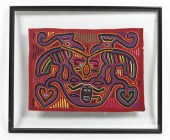 A Pair of Molas South American
A Pair of Molas South American circa 1970 unsigned. 13 x 17 1/2 inches each.
A Pair of Molas South American
A Pair of Molas South American circa 1970 unsigned. 13 x 17 1/2 inches each. -
 Extremely Rare Spanish Pedreynal
Extremely Rare Spanish Pedreynal Miquelet Pistol .560 bore diameter ? 23.5"? tapered octagonal barrel with round turned shoulders 8.5" from the breech and cannon-style muzzle.? Top of barrel with maker's mark PRAT in rectangular cartouche.? Face of frizzen with lock maker's?marks V?A LL S in a shield-style??cartouche.? Overall length is 28".? An extremely rare Spanish Ripoll Pedreynal miquelet pistol ca 1625-1650.?The Pedreynal is first mentioned in Cervantes Don Quixote published 1604.? This form of pistol is unique to the Ripoll area of Spain and has a wooden stock entirely sheathed in pierced steel.? The very long barrel is characteristic of the "Pedre?al."? The miquelet lock is of transitional or "agujeta" form.? The present example closely resembles the one on exhibit in the Museo de Ripoll [Graells 1971: 133 fig. 6 "A 70-cm 'pedrenal' with a 'transition' or agjueta lock: datable 1625-50." (Museo de Ripoll)].? A short version of this pistol by Molas formerly in the collection of William Goodwin Renwick was sold at Sotheby's London in 1971 to W. Keith Neal.? The present example was quite likely the only "Pedreynal" in private hands and is the only one to be offered at public sale in memory.Literature:Graells y Puig Eudaldo. "A Primer of Ripoll Gunlocks." Arms and Armor Annual 1971Blackmore Howard. European and American Arms.Blair Claude. Pistols of the World. Condition: Condition of this pistol is outstanding; it retains a very nice untouched patina. No restorations. Museum quality.
Extremely Rare Spanish Pedreynal
Extremely Rare Spanish Pedreynal Miquelet Pistol .560 bore diameter ? 23.5"? tapered octagonal barrel with round turned shoulders 8.5" from the breech and cannon-style muzzle.? Top of barrel with maker's mark PRAT in rectangular cartouche.? Face of frizzen with lock maker's?marks V?A LL S in a shield-style??cartouche.? Overall length is 28".? An extremely rare Spanish Ripoll Pedreynal miquelet pistol ca 1625-1650.?The Pedreynal is first mentioned in Cervantes Don Quixote published 1604.? This form of pistol is unique to the Ripoll area of Spain and has a wooden stock entirely sheathed in pierced steel.? The very long barrel is characteristic of the "Pedre?al."? The miquelet lock is of transitional or "agujeta" form.? The present example closely resembles the one on exhibit in the Museo de Ripoll [Graells 1971: 133 fig. 6 "A 70-cm 'pedrenal' with a 'transition' or agjueta lock: datable 1625-50." (Museo de Ripoll)].? A short version of this pistol by Molas formerly in the collection of William Goodwin Renwick was sold at Sotheby's London in 1971 to W. Keith Neal.? The present example was quite likely the only "Pedreynal" in private hands and is the only one to be offered at public sale in memory.Literature:Graells y Puig Eudaldo. "A Primer of Ripoll Gunlocks." Arms and Armor Annual 1971Blackmore Howard. European and American Arms.Blair Claude. Pistols of the World. Condition: Condition of this pistol is outstanding; it retains a very nice untouched patina. No restorations. Museum quality. -
 Opening Game Cincinnati National
Opening Game Cincinnati National League Park Chicago Vs Cincinnati 1912 Rare Panoramic Photograph Panoramic silver gelatin photograph titled in the negative lower right:?Opening Game / Cincinnati National League Park / Chicago Vs. Cincinnati / Attendance 27 366 and copyrighted in negative lower left:?Kaufmann Weimer & Fabry Co. / 425 S. Wabash Ave. Chicago. 1912. 18.5 x 50.5 in. (sight) matted and housed in wooden frame with engraved plaque attached that reads?Geo. Eckard.??This grand panoramic photo puts you in the seats for the opening of the new ballpark in Cincinnati on April 11 1912. Officially 26 336 fans (or "bugs" as they were then called) the largest crowd to that date in Reds history watched the inaugural contest between the Reds and the Chicago Cubs. This superb and rare photograph taken from a photographer's stand deep in the right field corner captures nearly every one of the attendees on that day plus the entire Reds lineup on the field.??The park built by Cincinnati architect Henry Hake opened with 20 000 seats but the club sold 26 336 tickets for the opener (the photograph's title mistakenly has 27 336) and in the custom of the day much of the overflow watched from the field of play including a group sitting on the terrace in left field. And dozens others watched from the open windows of the adjacent factory buildings while others took a precarious perch on the top of the outfield wall. The crowd on the field did not affect play much; this was the "dead ball" era and the dimensions of the park when it first opened were huge including a right field dimension of 400 feet!? In fact Redland Field was so large and the ball so "dead " that it was not until 1921 that a player hit a home run over the fence.?The name of the ballpark was not settled when it opened which is reflected in the lettering on the photo referring to the "Cincinnati National League Park."? Club owner Garry Herrmann had been urged by friends to name the park after himself Garry Park or Herrmann Field. Herrmann demurred and favored the generic "League Park" until a few days later when a fan suggested the name "Redland Field " in honor of the club's colors. Redland Field became official a few weeks later at the formal dedication ceremonies.?In 1934 Cincinnati businessman Powel Crosley bought the Reds and with an eye towards marketing his many consumer products that carried his name he officially changed Redland Field to Crosley Field.?Redland/Crosley was built during a new ballpark boom in the early 20th century; the increasing popularity of the game and advances in building materials spelled the end of the smaller wood and iron parks and gave way to larger concrete and steel structures. In fact just nine days after this photograph was taken Boston's Fenway Park opened.??Most of the crowd in attendance arrived at the park via streetcars that ran along Western Avenue just beyond the centerfield fence. Fans began lining up for the unreserved (25?) bleacher seats at 8 a.m. The park opened at noon (game time was 3 p.m.) and according to one reporter the mostly male crowd came with "cameras opera glasses and cushions; smoked bad cigars and some good ones drank green pop ate molasses popcorn and 'hot dogs...'"? By the looks of the litter in front of the bleachers a few brought whiskey bottles as well.??Prominent Reds players in the field include the right fielder Armando Marsans one of the first Latin players to play in the major leagues and left fielder Bob Bescher who the year before had set a National League record for stolen bases (81) that was not broken for over 50 years. At first base was Dick Hoblitzell the Reds leading hitter and later when he played with Boston Hoblitzell roomed with Babe Ruth. The Cubs in dark blue uniforms featured the Hall of Fame trio and the famed double-play combination of Joe Tinker Johnny Evers and Frank Chance.? And you will note just two umpires as was the practice of the day. The Reds won this opener rallying from a 5-1 deficit to win 10-6.?This photo also documents two other Crosley landmarks the terrace in front of the left field wall and the industrial building just behind the left field wall. This building eventually became the "laundry" the home of the Superior Towel and Linen Company.??In later years the Reds changed the appearance of the park. They added additional seats to the ballpark including field-level box seats in 1927 directly in front of the main grandstand which forced the club to move home plate out about 20 feet. They also double-decked the bleachers all the way to the foul poles (1939).? Lights went up in 1935 (the Reds were the first Major League team with lights) and new and larger scoreboards were constructed in 1934 and 1957.??This photograph is a fabulous example of the large panoramic photos popular in this era. Similar photographs of Fenway Park Wrigley Field and other ballparks are housed at the Library of Congress (and can be viewed on their website ?http://www.loc.gov/topics/baseball/photos/panorama.html). This is one of only two prints of this photograph known to exist. The other is the property of the Cincinnati Reds Museum.?Our sincere thanks to Cincinnati Reds Team Historian Greg Rhodes for providing us with this information. ? Condition: Light toning to print.?
Opening Game Cincinnati National
Opening Game Cincinnati National League Park Chicago Vs Cincinnati 1912 Rare Panoramic Photograph Panoramic silver gelatin photograph titled in the negative lower right:?Opening Game / Cincinnati National League Park / Chicago Vs. Cincinnati / Attendance 27 366 and copyrighted in negative lower left:?Kaufmann Weimer & Fabry Co. / 425 S. Wabash Ave. Chicago. 1912. 18.5 x 50.5 in. (sight) matted and housed in wooden frame with engraved plaque attached that reads?Geo. Eckard.??This grand panoramic photo puts you in the seats for the opening of the new ballpark in Cincinnati on April 11 1912. Officially 26 336 fans (or "bugs" as they were then called) the largest crowd to that date in Reds history watched the inaugural contest between the Reds and the Chicago Cubs. This superb and rare photograph taken from a photographer's stand deep in the right field corner captures nearly every one of the attendees on that day plus the entire Reds lineup on the field.??The park built by Cincinnati architect Henry Hake opened with 20 000 seats but the club sold 26 336 tickets for the opener (the photograph's title mistakenly has 27 336) and in the custom of the day much of the overflow watched from the field of play including a group sitting on the terrace in left field. And dozens others watched from the open windows of the adjacent factory buildings while others took a precarious perch on the top of the outfield wall. The crowd on the field did not affect play much; this was the "dead ball" era and the dimensions of the park when it first opened were huge including a right field dimension of 400 feet!? In fact Redland Field was so large and the ball so "dead " that it was not until 1921 that a player hit a home run over the fence.?The name of the ballpark was not settled when it opened which is reflected in the lettering on the photo referring to the "Cincinnati National League Park."? Club owner Garry Herrmann had been urged by friends to name the park after himself Garry Park or Herrmann Field. Herrmann demurred and favored the generic "League Park" until a few days later when a fan suggested the name "Redland Field " in honor of the club's colors. Redland Field became official a few weeks later at the formal dedication ceremonies.?In 1934 Cincinnati businessman Powel Crosley bought the Reds and with an eye towards marketing his many consumer products that carried his name he officially changed Redland Field to Crosley Field.?Redland/Crosley was built during a new ballpark boom in the early 20th century; the increasing popularity of the game and advances in building materials spelled the end of the smaller wood and iron parks and gave way to larger concrete and steel structures. In fact just nine days after this photograph was taken Boston's Fenway Park opened.??Most of the crowd in attendance arrived at the park via streetcars that ran along Western Avenue just beyond the centerfield fence. Fans began lining up for the unreserved (25?) bleacher seats at 8 a.m. The park opened at noon (game time was 3 p.m.) and according to one reporter the mostly male crowd came with "cameras opera glasses and cushions; smoked bad cigars and some good ones drank green pop ate molasses popcorn and 'hot dogs...'"? By the looks of the litter in front of the bleachers a few brought whiskey bottles as well.??Prominent Reds players in the field include the right fielder Armando Marsans one of the first Latin players to play in the major leagues and left fielder Bob Bescher who the year before had set a National League record for stolen bases (81) that was not broken for over 50 years. At first base was Dick Hoblitzell the Reds leading hitter and later when he played with Boston Hoblitzell roomed with Babe Ruth. The Cubs in dark blue uniforms featured the Hall of Fame trio and the famed double-play combination of Joe Tinker Johnny Evers and Frank Chance.? And you will note just two umpires as was the practice of the day. The Reds won this opener rallying from a 5-1 deficit to win 10-6.?This photo also documents two other Crosley landmarks the terrace in front of the left field wall and the industrial building just behind the left field wall. This building eventually became the "laundry" the home of the Superior Towel and Linen Company.??In later years the Reds changed the appearance of the park. They added additional seats to the ballpark including field-level box seats in 1927 directly in front of the main grandstand which forced the club to move home plate out about 20 feet. They also double-decked the bleachers all the way to the foul poles (1939).? Lights went up in 1935 (the Reds were the first Major League team with lights) and new and larger scoreboards were constructed in 1934 and 1957.??This photograph is a fabulous example of the large panoramic photos popular in this era. Similar photographs of Fenway Park Wrigley Field and other ballparks are housed at the Library of Congress (and can be viewed on their website ?http://www.loc.gov/topics/baseball/photos/panorama.html). This is one of only two prints of this photograph known to exist. The other is the property of the Cincinnati Reds Museum.?Our sincere thanks to Cincinnati Reds Team Historian Greg Rhodes for providing us with this information. ? Condition: Light toning to print.? -
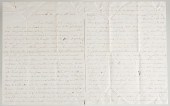 [Civil War - Manuscripts] Civil War
[Civil War - Manuscripts] Civil War Soldier's Letter Describing Sherman's March From Savannah GA 4pp dated January 5 1865 at Savannah Georgia. Writing to his brother P.H. Richardson You have doubtless learned that Sherman with his Yankee invaders have found their way to and into the City of Savannah. We left Atlanta on the 15th of Nov. for parts to us unknown & marched in all directions except West or Northwest but making our general course South East. He describes the terrain of coastal Georgia speaks of highly successful foraging to the point that he is the heaviest he has ever been (We had a plenty of Sweet Potatoes fresh Pork Beef & Molasses also some Honey etc so we lived fat & had a good time altho our March was a long one) and recounts the only fight along they way near Macon where one Union regiment terribly whipped 5 Brig. of rebs that charged them several times & were repulsed with terrible slaughter. He gives details of their entry in Savannah including dates resistance and other war news and describes Savannah as a fine city for a Southern one well laid out with paved streets and residents eager to take the oath of Allegiance. Richardson even gives his personal views on his ultimate superiors: I begin to think it was Sherman's head that made Grant so prominent a Gen. as you know 2 [drawing of a head] are better than one - still I don't feel to distrust Gen. Grant's ability as a General. The final page is full of news relevant to the correspondents' family and friends but closes with the plea O! when will this War be over is there any prospect of a Submission on their part ever or will the last man woman & Child be exterminated before submitting? O! for Grace to patiently endure & do our whole duty so long as duty Calls So I will will close wishing you Heaven's Choicest blessing here and hereafter and here I wish you a Happy New Year. Richardson does not sign with a rank but mentions in the letter that for the last few months he has been detailed with the Division Hospital 1st Div. 15th A.C. and is acting as Commissary Sargt. Condition: Very good.
[Civil War - Manuscripts] Civil War
[Civil War - Manuscripts] Civil War Soldier's Letter Describing Sherman's March From Savannah GA 4pp dated January 5 1865 at Savannah Georgia. Writing to his brother P.H. Richardson You have doubtless learned that Sherman with his Yankee invaders have found their way to and into the City of Savannah. We left Atlanta on the 15th of Nov. for parts to us unknown & marched in all directions except West or Northwest but making our general course South East. He describes the terrain of coastal Georgia speaks of highly successful foraging to the point that he is the heaviest he has ever been (We had a plenty of Sweet Potatoes fresh Pork Beef & Molasses also some Honey etc so we lived fat & had a good time altho our March was a long one) and recounts the only fight along they way near Macon where one Union regiment terribly whipped 5 Brig. of rebs that charged them several times & were repulsed with terrible slaughter. He gives details of their entry in Savannah including dates resistance and other war news and describes Savannah as a fine city for a Southern one well laid out with paved streets and residents eager to take the oath of Allegiance. Richardson even gives his personal views on his ultimate superiors: I begin to think it was Sherman's head that made Grant so prominent a Gen. as you know 2 [drawing of a head] are better than one - still I don't feel to distrust Gen. Grant's ability as a General. The final page is full of news relevant to the correspondents' family and friends but closes with the plea O! when will this War be over is there any prospect of a Submission on their part ever or will the last man woman & Child be exterminated before submitting? O! for Grace to patiently endure & do our whole duty so long as duty Calls So I will will close wishing you Heaven's Choicest blessing here and hereafter and here I wish you a Happy New Year. Richardson does not sign with a rank but mentions in the letter that for the last few months he has been detailed with the Division Hospital 1st Div. 15th A.C. and is acting as Commissary Sargt. Condition: Very good.
...many more examples with full details are available to our members - Learn more

